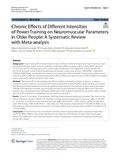Mostrar el registro sencillo del ítem
Chronic effects of different intensities of power training on neuromuscular parameters in older people: a systematic review with meta-analysis
| dc.creator | Guimarães, Marcelo Bandeira | es_ES |
| dc.creator | Blanco‑Rambo, Eduarda | es_ES |
| dc.creator | Vieira, Alexandra Ferreira | es_ES |
| dc.creator | Sáez de Asteasu, Mikel L. | es_ES |
| dc.creator | Pinto, Ronei Silveira | es_ES |
| dc.creator | Izquierdo Redín, Mikel | es_ES |
| dc.creator | Cadore, Eduardo L. | es_ES |
| dc.date.accessioned | 2023-11-13T17:35:47Z | |
| dc.date.available | 2023-11-13T17:35:47Z | |
| dc.date.issued | 2023 | |
| dc.identifier.citation | Bandeira-Guimarães, M., Blanco-Rambo, E., Vieira, A. F., Sáez de Asteasu, M. L., Pinto, R. S., Izquierdo, M., Cadore, E. L. (2023) Chronic effects of different intensities of power training on neuromuscular parameters in older people: A systematic review with meta-analysis. Sports medicine - open, 9(1), 1-12. https://doi.org/10.1186/s40798-023-00646-9. | en |
| dc.identifier.issn | 2199-1170 | |
| dc.identifier.uri | https://hdl.handle.net/2454/46749 | |
| dc.description.abstract | Background Power training (PT) has been shown to be an efective method for improving muscle function, includ‑ ing maximal strength, measured by one-repetition maximum (1RM), and power output in older adults. However, it is not clear how PT intensity, expressed as a percentage of 1RM, afects the magnitude of these changes. The aim of this systematic review (International prospective register of systematic reviews—PROSPERO—registration: CRD42022369874) was to summarize the evidence from randomized clinical trials (RCT) assessing the efects of lowintensity (≤49% of 1RM) and moderate-intensity (50–69% of 1RM) versus high-intensity (≥70% of 1RM) PT on maximal power output and maximal strength in older adults. Methods We included RCTs that examined the efects of diferent intensities of power training on maximum strength and power output in older people. The search was performed using PubMed, LILACS, Embase, and Scopus. Methodological quality was assessed using the preferred reporting items for systematic reviews and meta-analyses (PRISMA 2020 statement checklist), and the quality of evidence was determined using the PEDro scale. Data were analyzed using standardized mean diferences (SMD) with a 95% confdence interval (CI), and random efects models were used for calculations. A signifcance level of p≤0.05 was accepted. Results Three RCTs assessing 179 participants, all of high methodological quality, were included. There were no sig‑ nifcant diferences between diferent PT intensities in terms of power output gains for leg press [SMD=0.130 (95% CI −0.19, 0.45), p=0.425] and knee extension exercises [SMD: 0.016 (95% CI −0.362, 0.395), p=0.932], as well as leg press 1RM increases [SMD: 0.296 (95% CI −0.03, 0.62); p=0.072]. However, high-intensity PT (70–80% of 1RM) was sig‑ nifcantly more efective than low-intensity PT in increasing 1RM for knee extension exercise [SMD: 0.523 (95% CI 0.14, 1.91), p=0.008]. Conclusions PT performed at low-to-moderate intensities induces similar power gains compared to high-inten‑ sity PT (70–80% of 1RM) in older adults. Nonetheless, the infuence of PT intensity on lower-limb strength gains seems to be dependent on the assessed exercise. Cautious interpretation is warranted considering the inclusion of only three studies. | es_ES |
| dc.format.mimetype | application/pdf | en |
| dc.format.mimetype | application/msword | en |
| dc.language.iso | eng | en |
| dc.publisher | Springer | en |
| dc.relation.ispartof | Sports Medicine - Open (2023), 9:98 | en |
| dc.rights | © The Author(s) 2023. This article is licensed under a Creative Commons Attribution 4.0 International License. | en |
| dc.rights.uri | http://creativecommons.org/licenses/by/4.0/ | |
| dc.subject | Ageing | en |
| dc.subject | Muscle strength | en |
| dc.subject | Resistance training | en |
| dc.subject | Muscle power | en |
| dc.subject | Training intensity | en |
| dc.title | Chronic effects of different intensities of power training on neuromuscular parameters in older people: a systematic review with meta-analysis | en |
| dc.type | Artículo / Artikulua | es |
| dc.type | info:eu-repo/semantics/article | en |
| dc.date.updated | 2023-11-13T16:38:39Z | |
| dc.contributor.department | Ciencias de la Salud | es_ES |
| dc.contributor.department | Osasun Zientziak | eu |
| dc.rights.accessRights | Acceso abierto / Sarbide irekia | es |
| dc.rights.accessRights | info:eu-repo/semantics/openAccess | en |
| dc.identifier.doi | 10.1186/s40798-023-00646-9 | |
| dc.relation.publisherversion | https://doi.org/10.1186/s40798-023-00646-9 | |
| dc.type.version | Versión publicada / Argitaratu den bertsioa | es |
| dc.type.version | info:eu-repo/semantics/publishedVersion | en |



